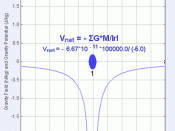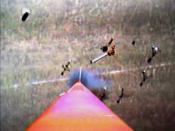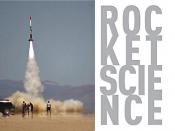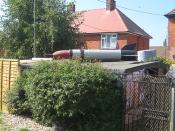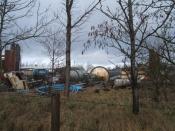Daily Responses Day 1 Procedure: We made a rough sketch of a rocket that we will possibly build in day 2. We decided on putting a twenty-four-ounce bottle on top of a two-liter bottle. We also decided to put fins on the rocket that are about as long as the two-liter bottle.
Day 2 Procedure: We decided on a two-bottle design. We put together a two-liter bottle and a twenty four-ounce bottle on top of the two-liter bottle with duct tape. We put three fins on the two-liter bottle that were made out of cardboard.
Day 3 Procedure: We filled our two-liter bottle one third of the way full. We launched the rocket and it carried a distance of about one hundred meters. We thought it flew very well but we are still going to improve on it in day four.
Day 4 Procedure: We put new fins on the rocket and made them out of maintenance free house siding.
We also made a nose cone out of an ice cream bucket cover. We didn?t have time to put the nose cone on the top of our rocket but tested it anyway. The rocket went directly to the right and didn?t go very far, we probably need to adjust the positions of our fins.
Day 5 Procedure: We cut our top twenty four-ounce bottle in half and put wet paper towels in the remaining half to give the top end some more weight. Then we put a new twenty-ounce bottle over the bottom half and the paper towels. We then re-taped our fins and tested our rocket. Our rocket went one hundred twenty meters.
Day 6 Procedure: We started to build our parachute rocket today. We made a design for our parachute. Our parachute is 32 inches in diameter. We made eight holes equally spaced around the edge of our parachute. We discarded the whole top of our preciously made rocket.
Day 7 Procedure: We put strings on our parachute. We then made a nose cone out of paperboard and attached it to the top bottle with a string. We reinforced the nose cone with tape. We also attached a twenty-ounce bottle to the base two liter bottle to put our parachute in.
Day 8 Procedure: We attached strings to our rocket from our parachute. We did this by putting our eight strings in two groups of four and attaching them side-by-side and taping them. We tested our rocket, it went very high but the parachute didn?t come out. The second time we tested the parachute came our but the strings got tangled in the string attached to our nose cone.
Day: 9 Procedure: We removed the string attached to our nose cone. We also put a little more weight to the bottom of our rocket. We gathered all the information we needed before we tested our parachute rocket. My partner and me decided to fill our two-liter bottle with about nine hundred milliliters of water. The first time we tested our rocket it didn?t do very well at all so we decided to test it again. The second test went fairly well, our rocket went about sixty-nine meters high but the parachute didn?t come out.
Distance Rocket Introduction: We are building this rocket for distance. The more distance the rocket travels the better. We are testing Newton?s laws by launching a rocket made out of plastic bottles and propelled by one hundred pounds of air pressure inside a two liter bottle.
Purpose: The purpose is to build a rocket out of plastic bottles and tape and make it go the greatest distance possible and to test Newton?s three laws of motion.
Hypothesis: My partner and I predict that the rocket that we built we do fairly well. In previous flights we estimated that our rocket went about one hundred meters. We believe our rocket will go about one hundred meters if not farther.
Procedure: on separate sheet of paper DATA Mass 418g Weight 4.09n Water volume 850ml Center of gravity 31.5cm Center of pressure 31.5cm Distance 120m Velocity 23.62m/sec.
Momentum 9873.16 Potential energy 232742.4 Kinetic energy 116602.01 Time 5.08sec Height of rocket 63cm Summary: We learned the basic fundamentals of the distance objects travel when considering mass, length, center of pressure, center of gravity, water volume, height of the rocket, weight of the rocket, fin size, fin length, fin position, and aerodynamics. We have concluded that the size, shape and position of the fins on our rocket have an effect on the rockets flight, me and my partner experienced this first hand in one of our distance tests when the rocket went directly to the right after launch. Our rocket went 120 meters and may have gone further if our fins were exactly positioned to the best of our abilities. My partner and me also concluded that the volume of water does have and effect on the distance a rocket will travel, a teacher showed us this with three examples. Newton?s first law comes into play when the rocket is in the air and gravity effects it by bringing it down to the ground. Newton?s second law applies to this activity considering that the heavier rockets didn?t travel as far as the lighter weighted rockets. Newton?s third law relates to this activity by the one hundred pounds of air pressure acting on the water in the rockets bottle chamber. The water moves in a downward force while the rocket moves in an upward force, hence *For every action there is an equal and opposite reaction.* Conclusion: Our hypothesis stated that our rocket will go one hundred meters or farther and it was correct. Our rocket went one hundred twenty meters and that, for the most part, supported our hypothesis. Isac Newton was correct for every action there is an equal and opposite reaction the action was the water spraying out of the bottom and the reaction from that was the rockets movement forward. Newton?s second law was correct and displayed when the heavier weighted rockets didn?t go as far as the lighter rockets. Newton?s first law was also correct and shown when the rocket was motivated in a forward motion and was acted upon by force called gravity.
Altitude and parachute Rocket Introduction: We are building this rocket for altitude and time aloft. The higher and the more time the rocket spends in the air the better. We are testing Newton?s laws by launching a rocket equipped with a parachute straight up in the air and getting information from that launch.
Purpose: To build a rocket to achieve the greatest altitude and the longest time spent up in the air as possible. Also to understand how Newton?s three laws of motion relate to events and data that occur in the launch of our rocket.
Hypothesis: Since we tested our rocket two times and the parachute didn?t open either time, we predict that the parachute will not release and catch air. It would be nice to see the parachute open on the test but from considering our two previous experiences the outlook of that doesn?t look good.
Procedure: on separate sheet of paper Length 50cm Mass 232g Weight 2.52n Water volume 900ml Center of pressure 25cm Center of gravity 22cm Parachute diameter 81cm Number of strings 8 Length of strings 42cm Number of fins 3 Fin size 17cm Time up 1.63sec Time down 6.81sec Velocity up 42.33m/sec Velocity down 10.13m/sec Potential energy up 415567.68 Potential energy down 23691.84 Kinetic energy up 207852.15 Kinetic energy down 11903.56 Acceleration up/down 25.96/1.48 Summary: We learned the basic fundamentals of Newton?s three laws of motion. We concluded that the size of the fins do matter, our fins were a good size at seventeen centimeters that kept our rocket stable and in a straight flight. Fins also need to be precisely placed on the base bottle of the rocket, if the fins are not precisely placed there is a risk of an indirect flight. The mass and the volume of the water depend on the rockets flight, the heavier the rocket the lower maximum altitude it will have and if too much water is put in the base bottle the rocket wont fly with success. All of Newton? laws apply to this rocket activity. Newton?s first law applies to this test because of the rocket slowing and falling caused by an unbalanced force (gravity). Newton?s third law relates to this flight test by the water moving in a downward motion and the rocket moving in an upward motion.
Conclusion: Our hypothesis stated that the parachute will not open and that?s exactly what happened. We didn?t really reach our expectations because we would have liked for our parachute to open and have more time in the air. We proved Sir Isac Newton to be correct with our rocket test and the data we achieved after launching our rocket.
